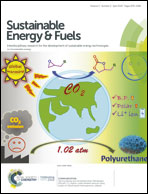Dehydrogenation of formic acid using molecular Rh and Ir catalysts immobilized on bipyridine-based covalent triazine frameworks†
Abstract
In this study, catalytic dehydrogenation of formic acid into H2/CO2 using half-sandwich Rh(III)/Ir(III) catalysts immobilized on variable dimensions of bipyridine-based covalent triazine frameworks (bpy-CTFs) has been described for the first time with a highest initial turnover frequency of 7930 h−1. A systematic study on the influence of the central metal cation (Rh vs. Ir), CTF architectures and amount of metal loadings on the CTF is presented.



 Please wait while we load your content...
Please wait while we load your content...